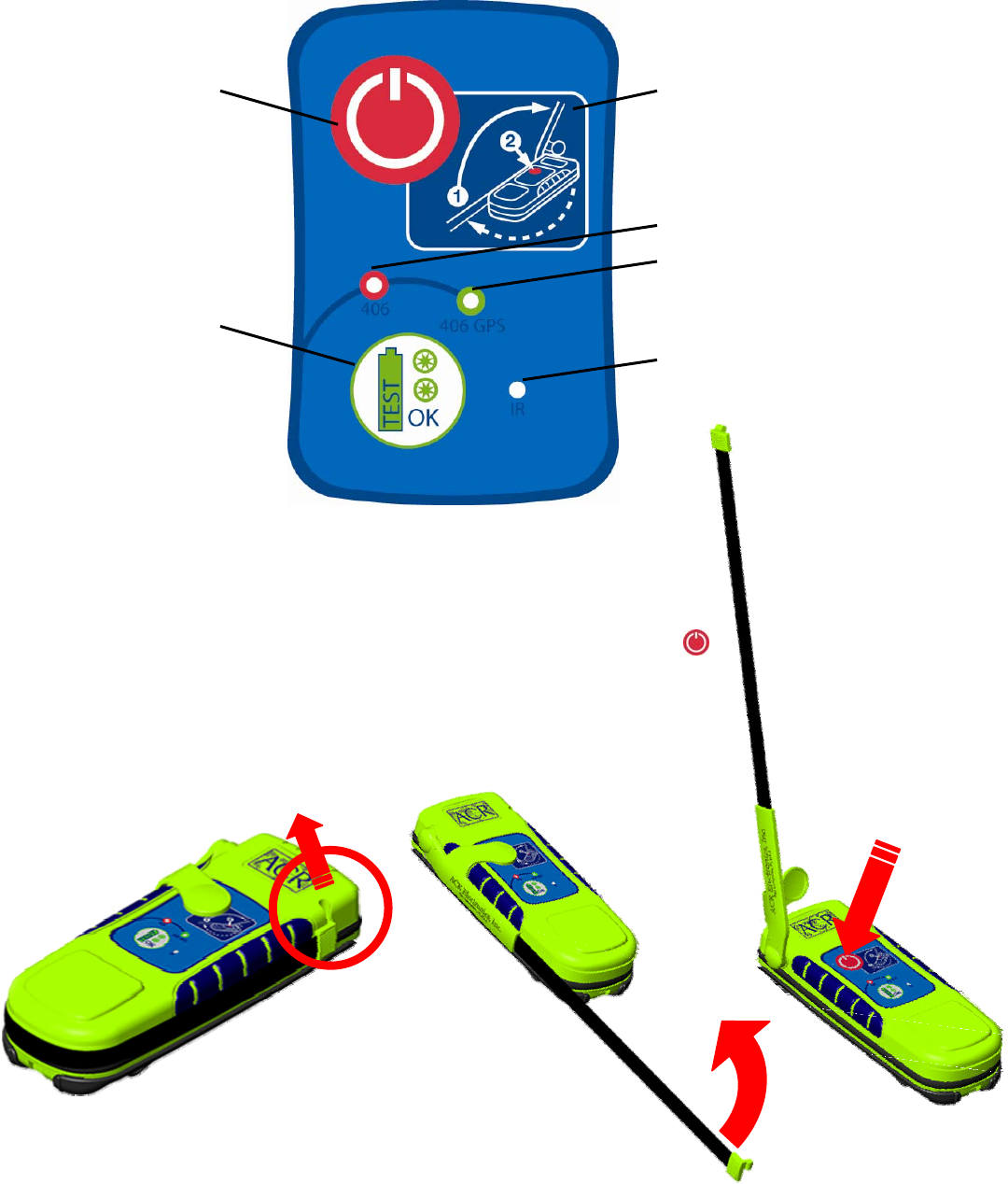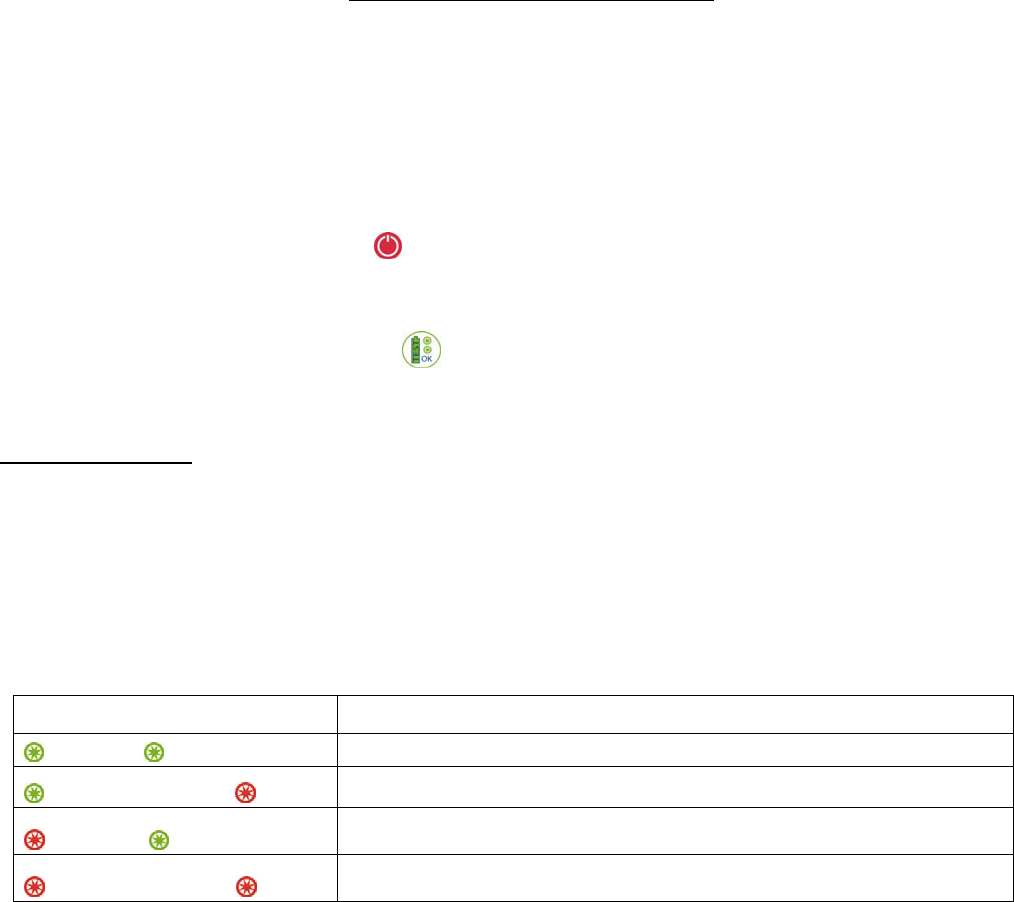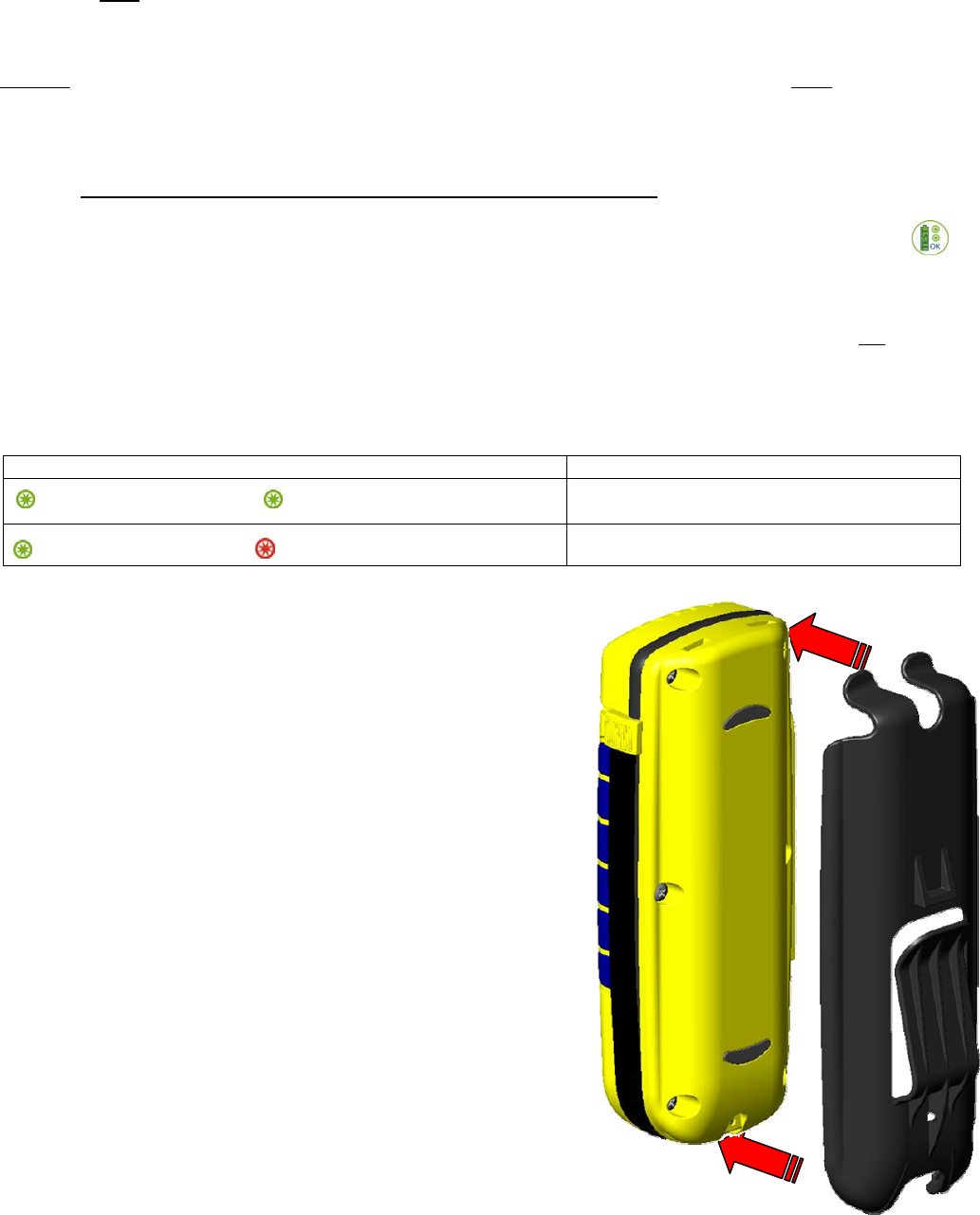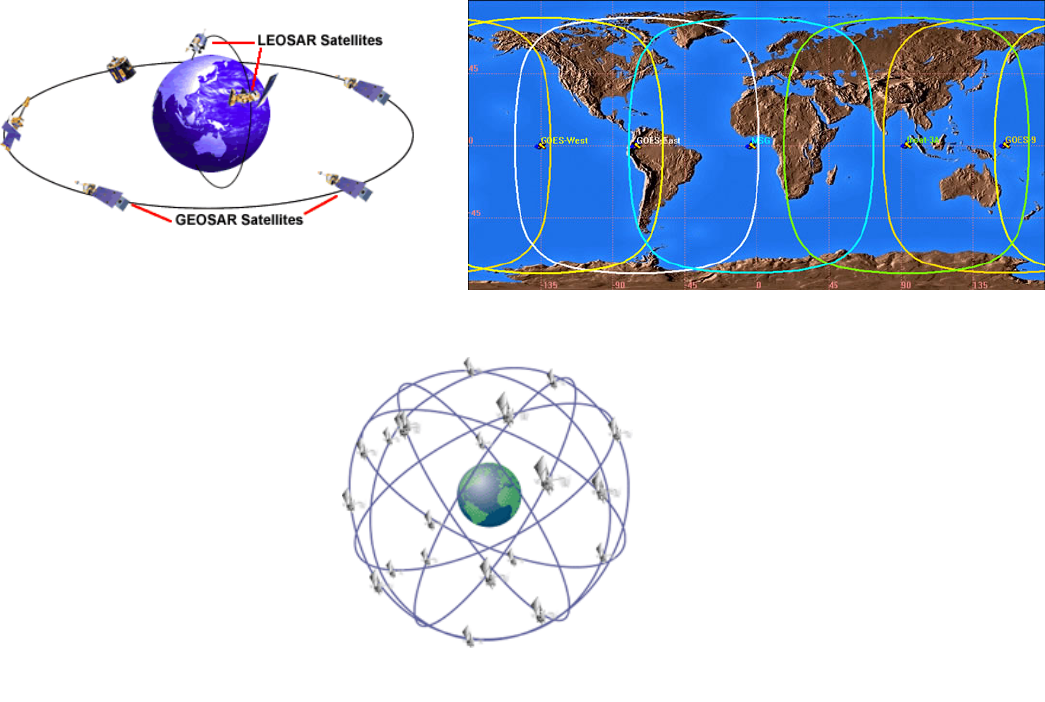ACR Electronics ACR-PLB-300 Personal Locator Beacon User Manual Y1 03 0215 T3
ACR Electronics, Inc. Personal Locator Beacon Y1 03 0215 T3
Users Manual

Y1-03-0215 Rev T1
0
Product Support Manual
ResQFix™ 406
GPS Personal Locator Beacon
Product No. 2897
PLB-300
Y1-03-0215
Rev. T3
Personal Locator Beacon
FCC Pending
ACR Electronics, Inc.
5757 Ravenswood Road
Fort Lauderdale, Fl 33312
Tel : +1(954) 981-3333
Fax: +1 (954) 983-5087
www.acrelectronics.com
Email: Info@acrelectronics.com

Y1-03-0215 Rev T3
i
* * * WARNING * * *
THIS TRANSMITTER IS AUTHORIZED FOR USE ONLY DURING SITUATIONS OF
GRAVE AND IMMINENT DANGER
* * * DELIBERATE MISUSE MAY INCUR A SEVERE PENALTY * * *
For proper use refer to section 2 – Responsible Use
PLEASE READ ALL INSTRUCTIONS BEFORE PERFORMING ANY OF THE TESTS.
FOREWORD
Congratulations and thank you for purchasing the ACR ResQFix™ 406 GPS Personal Locator Beacon. The combination
of superior design, high quality raw materials and quality controlled manufacturing produce a product that will perform for
years to come. The Test Facility at ACR can reproduce some of the harshest environmental conditions known to man.
This assures that the life saving devices can stand up to the rigors found in any environment on earth. With proper care
and maintenance, your PLB will be in service for years.
ACR is proud to be certified to the ISO 9001:2000, the International Standard for Quality.
This manual provides operation and maintenance instructions for the ResQFix™ 406 GPS PLB, hereinafter referred to
as the PLB or Beacon. This manual also describes the characteristics and details of the PLB System.
TABLE OF CONTENTS
SECTION 1 - REGISTRATION OF 406 MHZ PLBs.............................................................................................................. 1
1.1 REGISTRATION IMPORTANCE........................................................................................................................................... 1
1.2 WHERE TO REGISTER ..................................................................................................................................................... 1
1.3 REGISTRATION IN THE UNITED STATES ............................................................................................................................ 1
1.4 REGISTRATION IN CANADA .............................................................................................................................................. 1
1.5 REGISTRATION OUTSIDE OF THE UNITED STATES............................................................................................................. 1
1.6 CHANGE OF OWNERSHIP OR CONTACT INFORMATION ........................................................................................................ 2
1.7 LOST OR STOLEN PLB’S................................................................................................................................................. 2
SECTION 2 – RESPONSIBLE USE...................................................................................................................................... 2
2.1 PREVENTING FALSE ALARMS .......................................................................................................................................... 2
SECTION 3 – OPERATION................................................................................................................................................... 3
3.1 ACTIVATION.................................................................................................................................................................... 3
3.2 ACTIVATION WITH GPS................................................................................................................................................... 4
3.3 GPS RECEIVER ORIENTATION ........................................................................................................................................ 4
3.4 406/121.5 ANTENNA POSITION ....................................................................................................................................... 4
3.5 DEACTIVATION ............................................................................................................................................................... 4
3.6 SELF TEST ..................................................................................................................................................................... 4
3.7 BATTERY WITNESS SEAL LIFE......................................................................................................................................... 4
3.8 GPS TESTING................................................................................................................................................................ 5
SECTION 4 – PLB ATTACHMENT CLIPS............................................................................................................................ 5
SECTION 5 - CARE AND MAINTENANCE........................................................................................................................... 6
5.1 BATTERY REPLACEMENT ................................................................................................................................................ 6
SECTION 6 - THE SEARCH AND RESCUE SYSTEM......................................................................................................... 6
6.1 GENERAL OVERVIEW ...................................................................................................................................................... 6
6.2 SATELLITE DETECTION.................................................................................................................................................... 6
6.3 GLOBAL POSITIONING SYSTEM (GPS)............................................................................................................................. 7
SECTION 7 – AUTHORIZATIONS........................................................................................................................................ 7
7.1 CHARACTERISTICS ......................................................................................................................................................... 7
SECTION 8 - TECHNICAL DATA - RESQFIX™ 406............................................................................................................ 8
8.1 APPLICABLE DOCUMENTS ............................................................................................................................................... 8
8.2 SPECIFICATIONS............................................................................................................................................................. 8
SECTION 9 – FREQUENTLY ASKED QUESTIONS............................................................................................................ 9
SECTION 10 – LIMITED WARRANTY................................................................................................................................ 10
SECTION 11 – CUSTOMER SUPPORT INFORMATION .................................................................................................. 10

Y1-03-0215 Rev T3
1
SECTION 1 - REGISTRATION OF 406 MHZ PLBs
1.1 Registration Importance
It is mandatory that the owner of this 406 MHz PLB registers it with the National Authorities*. All 406 MHz PLBs
transmit a Unique Identifier Number (UIN) when activated. This UIN is programmed in the PLB based on the
country in which the PLB was purchased. Registration provides the Search and Rescue (SAR) forces with
emergency contact information, and will speed the launch of a rescue operation. The National Authorities use the
information to verify if an actual emergency exists. Valuable Search and Rescue resources are wasted every year
responding to false alarms. For PLBs that are not registered, SAR authorities will not know who you are, or who to
contact regarding additional information of your current situation. This could delay the launch of a rescue operation.
*A National Authority is the governmental body that is responsible for PLB Registration Database administration for
the country for which the PLB is programmed.
1.2 Where to register
The owner of a 406 MHz PLB should register it with the National Authority of which the PLB was programmed,
(typically the country where purchased), regardless of where you use your PLB. Each PLB is programmed with a
UIN for the country where the unit is shipped, and will only be accepted for registration in that country. To verify the
country for which a PLB is programmed, see the label with the UIN on the back of the unit. Units that do not have a
country specified on the UIN label are programmed for the United States. For a list of the national authorities in
your area, please refer to: http://www.cospas-sarsat.com/Management/listOfParticipants.htm
1.3 Registration in the United States
It is the Owner’s responsibility and is required by law to Register 406 MHz PLBs that are programmed for and
purchased in the United States. The National Authority that accepts registrations in the United States is the
National Oceanic and Atmospheric Administration (NOAA). The owner should complete the enclosed registration
form (Do not confuse this with the ACR Electronics Warranty Card) and mail it with the pre-addressed; postage
paid envelope to: SARSAT Beacon Registration,
E/SP3, RM 3320, FB-4
NOAA/NESDIS 4
5200 Auth Rd.
Suitland, MD 20746-4304
PLB registration is also available online at: www.beaconregistration.noaa.gov
The information provided on the Registration Form is used only for rescue purposes. The Registration Form should
be filled out and mailed immediately. Registration can be expedited by faxing the registration form or by completing
the form online in the event the PLB is to be placed in immediate use.
Typically, registration forms will be entered in the 406 MHz PLB Registration Database within 48 hours of receipt. A
confirmation letter, a copy of the actual registration and a proof-of-registration decal will be mailed to you within two
weeks. When you receive these documents, please check the information carefully and affix the decal to your PLB
in the area marked “Beacon Decal here”. If you do not receive confirmation, contact NOAA for additional
information at: +1-888-212-7283.
1.4 Registration in Canada
The National Authority in Canada is the NSS (National Search & Rescue Secretariat). Canadian residents can
register online at http://beacons.nss.gc.ca/ For more information please contact the NSS at (613) 966-1504 or
(800) 727-9414. National Search and Rescue Secretariat
400-275 Slater Street
Ottawa, Ontario K1A 0K2
1.5 Registration Outside the United States
In countries other than the United States, 406 MHz PLBs are registered with that country’s National Authority at the
time of Purchase. The Sales agent should assist in filling out the forms and sending to that country’s National
Authority. To verify that the unit is properly programmed for that country, view the UIN label on the side of the unit.
In the event that the PLB is not programmed for the country in which it has been purchased, the sales agent, (if
properly equipped) can reprogram the unit for that country.

2 Y1-03-0215 Rev. T3
1.6 Change of ownership or contact information
It is the owner’s responsibility to advise the National Authority of any change in the information on the registration
form. If the current owner of the PLB is transferring the PLB to a new owner, the current owner is required to inform
the National Authority by Letter, Fax or telephone, of the name and address of the new owner. The new owner of
the PLB is required to provide the National Authority with all of the information requested on the Registration form.
This obligation transfers to all subsequent owners. Registration forms are available from NOAA by calling +1(888)
212-7283 or visit our website at: www.acrelectronics.com.
1.7 Lost or stolen PLB’s
Inform NOAA immediately at 1-888-212-SAVE (7283), or your national authority, that your beacon has been lost or
stolen. They will update your beacon registration information with the appropriate information.
Things That You Need To Do if your beacon was stolen:
• Report to your local police department that the PLB has been stolen.
• Contact NOAA at 1-888-212-SAVE (7283), or your national authority, with the following information so your
PLB registration information can be updated with the appropriate remarks:
Police Department Name
Police Phone Number
Police Case Number
If your PLB were to activate, the information you provide will be forwarded to the appropriate Search and Rescue
Authorities who will ensure that your PLB gets back to you. And, if someone attempts to register a PLB reported as
stolen, NOAA or your national authority will notify the appropriate Police Department.
Visit the COSPAS-SARSAT website for more detailed information: www.cospas-sarsat.org
SECTION 2 – RESPONSIBLE USE
The ResQFix™ 406 GPS PLB is a satellite signaling device of last resort, for use when all other means of self-rescue
have been exhausted; where the situation is grave and imminent and the loss of life, limb, eyesight or valuable property
will occur if assistance is not received. Deliberate misuse may incur a severe penalty.
2.1 Preventing False Alarms
Ensure that your PLB is registered with NOAA or your national authority. This does nothing to reduce false alarm
rates, but does have a dramatic effect on the impact of a false alarm. If the PLB is properly registered, the situation
will be resolved with a phone call. It will also help speed rescue in an actual distress.
Use care when leaving your PLB and with whom you leave it. Ensure that they are aware of the device and know
the ramifications of causing a false alarm. Many false alarms are generated by curious individuals.
Maintain your PLB. Ensure that the batteries are within their expiration date and that all manufacturer
recommendations are followed.
The COSPAS-SARSAT satellites are very good at detecting emergency PLBs. An activation of a 406 MHz PLB for
just a few seconds will usually be detected. After a few minutes, it will usually be detected and located. This is good
if you're in distress, but if you're not, you just generated a false alarm.
Should there be an inadvertent activation or false alarm, it must be reported to the nearest search and rescue
authorities. The information that should be reported includes the PLB Unique Identifier Number (UIN), Date, Time,
duration and cause of activation, as well as location of PLB at the time of activation. Outside the United States
contact your National Authority.
To report false alarms in the United States contact any of the following:
Atlantic Ocean / Gulf of Mexico - USCG Atlantic Area Command Center Tel: (757) 398-6390
Pacific Ocean Area - USCG Atlantic Area Command Center Tel: (510) 437-3700
USCG HQ Command Center (From any location) Tel: (800) 323-7233
NOAA (National Oceanic and Atmospheric Administration) Tel: 1-888-212-SAVE (7283)

3 Y1-03-0215 Rev. T3
SECTION 3 – OPERATION
The ResQFix™ 406 GPS PLB models are designed to be manually deployed and activated. It is only to be activated
when all other means of self-rescue have been exhausted. Activation of a properly registered PLB tells Search
and Rescue who you are, where you are, and that you are facing a life threatening situation.
3.1 Activation
To activate your PLB in an emergency situation, unfasten the antenna from the
case and move it into the upright position (See Figure 2). Depress the ON
button 1 full second. Your PLB is now activated. While transmitting your
emergency signal, the red LED will flash once every 2 seconds alerting you that
your PLB is transmitting.
Figure 2 - Activation
e
c
d
Figure 1 - Key Pad Functions
Activation pictogram
406 MHz
Programming
Interface
406 MHz with GPS
ON/OFF Button
Test Button

4 Y1-03-0215 Rev. T3
3.2 Activation with GPS
This PLB is equipped with an internal GPS receiver. Once activated the GPS engine will start up and search to find
your LAT/LON and incorporate it into your 406 MHz signal. As soon as the GPS receiver acquires good positioning
data the red LED will stop blinking and the green LED will begin flashing once every 2 seconds. Once good global
positioning data has been obtained, the GPS receiver waits for 20 minutes before looking for new positioning data
again. If for any reason a time period of 4 hours passes without the GPS receiver being able to update the last
good set of GPS coordinates, the 406 message being transmitted will revert to the default data. At this point the
green LED will stop blinking and the red LED will flash once every 2 seconds until new GPS coordinates have been
obtained.
3.3 GPS Receiver Orientation
When activated it is critical that you do not cover the front bottom portion of the PLB with any body part, water,
clothing, etc. The GPS receiver is located under the front bottom portion of the case behind the product logo. To
ensure proper operation it needs to be unobstructed with a clear view to the sky.
In order to acquire GPS data, you must have your PLB outside with a clear view to the sky.
3.4 406/121.5 Antenna Position
For maximum performance you must deploy the PLB antenna into the proper position (see Figure 2). The antenna
will snap into place and be slightly slanted to the back. Be sure the antenna is positioned facing the sky and avoid
submerging in water.
This device is designed to operate on GROUND and ABOVE GROUND, it is not intended to operate while floating in water.
3.5 Deactivation
To deactivate your PLB, depress the OFF button for 1 second.
Once off, all blinking LED’s will stop signifying that the PLB is no longer sending your rescue message.
3.6 Self Test
Self test is initiated by holding the test button for at least ½ second and less than five seconds. Your PLB will
sound an initial beep and green LED (Light Emitting Diode) flash to signify the test has begun. The green LED will
flash a second time to indicate that the self test was successful.
Components Tested: Data Integrity and Memory; 406 MHz Synthesizer; RF Power/Battery; GPS header
If you encounter a RED LED at the completion of the self test, your PLB has failed, repeat the self test. If the
problem persists, please contact ACR Electronics or an authorized Battery Replacement Center for servicing of
your PLB.
NOTE: During a self test your PLB will send a 406 MHz signal coded as self-test to the satellite system. The
homing signal at 121.5 MHz is inhibited during self test; this allows you to test your PLB any time during the day
without causing any false alarms.
ACR strongly recommends performing the self test on a monthly basis.
Self Test Sequences Test Guide
4 BEEPS Successful Self Test
Less then 4 BEEPS Failed Self Test
4 BEEPS Successful Test – At least 1 hour of battery power has been depleted,
have battery replaced.
Less then 4 BEEPS Failed – Return unit to ACR for service. At least 1 hour of battery power
has been depleted, have battery replaced.
3.7 Battery Witness Seal Life
If your PLB flashes an initial Red LED at the beginning of the Self Test, this indicates that your electronic witness
has been broken and you have used more than 1 hour of battery life. While the PLB will still operate normally in an
emergency, ACR strongly recommends you have your battery replaced and the electronic witness reset to ensure
that you will have 24 hours of battery power should you ever need to activate your unit in an emergency

5 Y1-03-0215 Rev. T3
3.8 GPS Testing
This test is NOT required as 100% of all GPS receivers that leave ACR have been tested to ensure they perform
perfectly. However, if you would like to ensure your GPS receiver is working properly, please follow these
instructions very closely.
Warning: To conserve battery power the following test should not be performed more than once during the five-
year life of the battery pack!
Note: The GPS receiver is located under the bottom front portion of the case. It is imperative that this location not
be obstructed during self test or activation to ensure that the GPS receiver is acquiring your latitude and longitude
position. This test must be performed outside with a clear view of the sky.
The PLB must remain under observation in order to witness the results of the test. When the test button is
pressed for greater than 5 seconds the green LED will flash indicating that the GPS has been turned ON and a live
test of the internal GPS receiver has begun. The GPS will remain ON until LAT/LON position coordinates have
been obtained or until 10 minutes has elapsed. If good location data has been obtained, the GPS will be turned
OFF and the green LED will light for at least 3 seconds along with a long beep. This LAT/LON data is not saved for
use when the PLB is turned ON. The green LED is proof that the GPS is functioning properly and that the PLB is in
a location or environment where it can receive the necessary signals from satellites. If the GPS does not acquire
good navigation data, the GPS will turn OFF after 10 minutes and a RED LED will light for 3 seconds along with a
long beep.
GPS Test Sequences (max. 10 minutes) GPS Test Guide
and BEEP (Start of test) Long BEEP Successful Acquired GPS Data
and BEEP (Start of test) Long BEEP GPS data was not successfully acquired
SECTION 4 – PLB ATTACHMENT CLIPS
The ResQFix™ comes standard with an attachment clip. To install
the clip, simply align the bottom tabs on the clip with the insert holes
located on the bottom of the PLB. Snap the clip in place by pressing
the top of the clip so that the two top tabs engage in the two insert
holes on the top of the PLB (See figure 3).
The ResQFix™ clip has been designed to accommodate your
extreme adventures. You can secure your PLB directly to backpack
webbing straps, life jackets or belts to ensure the PLB is close at
hand. ACR recommends that you secure your PLB someplace that is
easily accessible in case of an emergency for rapid activation.
Ensure the PLB is secured firmly and is protected before heading out
to avoid damage or loss.
Note: ACR recommends that once you have clipped your PLB in
place that you also anchor the PLB with the lanyard to your life
jacket, backpack, etc. to ensure the unit will not be lost if it should
break out of the clip.
Figure 3- PLB Clip
c
d

6 Y1-03-0215 Rev. T3
SECTION 5 - CARE AND MAINTENANCE
Carefully inspect the PLB case and gasket for any visible cracks or damage. Cracks may admit moisture, which
could cause a malfunction. In the event of any cracking or structural damage, the PLB should be immediately sent
to ACR for evaluation and repairs, (1-800-432-0227).
Do Not clean your PLB with household cleaners and materials such as gasoline, benzene, bleach, sanitizers,
soaps, etc., simply wipe your PLB down with a damp cloth until clean.
5.1 Battery Replacement
Power is provided by self contained long life batteries with a five-year recommended replacement cycle. See
Factory Authorized Service Center for replacement.
The batteries (P/N 1100) must be replaced by the date indicated on the PLB. At each inspection, check the time
remaining until replacement is required. Batteries should be replaced if the PLB has been activated for any use
other than the self test.
Batteries should be replaced at an Authorized Battery Replacement Center. Services include: replacement of
battery packs and disposal of expired lithium batteries, gasket and O-ring examination and replacement if
necessary, lubricated gaskets and O-ring, air pressure test to ensure water tight integrity, and a full electronics
diagnostic check.
NOTE: This unit is a life saving device and all repairs and replacements need to be made by ACR or an ACR
authorized battery replacement center to ensure the beacon will perform properly when called upon.
For the nearest location of an ACR authorized service center, call 1-800-432-0227 (toll free) or visit our website at
www.acrelectronics.com
SECTION 6 - THE SEARCH AND RESCUE SYSTEM
6.1 General Overview
The PLB provides distress message on 406 MHz to satellites of the COSPAS-SARSAT network and to the
GEOSAR network that includes GPS latitude and longitude coordinates when GPS data is present.
The message transmitted is unique for each PLB, which provides identification of the transmitter through computer
access of registration files maintained by the National Oceanic and Atmospheric Administration or other National
Authority. Remember, if your PLB is not registered, Search and Rescue (SAR) Authorities do not know who you
are, or how to contact anyone who might know anything about your situation (Refer to section 1).
Once the signal (406 MHz) is relayed through the LEOSAR and/or GEOSAR network, SAR forces determine who is
closest, and then track the signal using the 121.5 MHz homing frequency for intermediate and short-range location.
6.2 Satellite Detection
The PLB transmits to the satellite portion of the COSPAS-SARSAT System. COSPAS-SARSAT is an international
system that uses Russian Federation and United States low altitude, near-polar orbiting satellites (LEOSAR) that
assist in detecting and locating activated 121.5/243 MHz beacons and 406 MHz Satellite beacons.
COSPAS and SARSAT satellites receive distress signals from PLBs transmitting on the frequency of 406 MHz. The
COSPAS-SARSAT 406 MHz beacon signal consists of a transmission of non-modulated carriers followed by a
digital message format that provides identification data. The 406 MHz system uses Satellite-borne equipment to
measure and store the Doppler-shifted frequency along with the beacons digital data message and time of
measurement. This information is transmitted in real time to an earth station called the Local User Terminal (LUT),
which may be within the view of the satellite, as well as being stored for later transmission to other LUTs.
The LUT processes the Doppler-shifted signal from the LEOSAR and determines the location of the beacon; then
the LUT relays the position of the distress to a Mission Control Center (MCC) where the distress alert and location
information is immediately forwarded to an appropriate Rescue Coordination Center (RCC). The RCC dispatches
Search and Rescue (SAR) forces.

7 Y1-03-0215 Rev. T3
The addition of the GEOSAR Satellite system greatly improves the reaction time for a SAR event. This satellite
system has no Doppler capabilities at 406 MHz, but will relay the distress alert to any of the LUT stations. When
there is GPS data included in the distress message, SAR authorities instantly know your location to within 110
yards. This speeds up the reaction time by not having to wait for one of the LEOSAR satellite to pass overhead.
Because most of the search and rescue forces presently are not equipped to home in on the 406 MHz Satellite PLB
signal, homing must be accomplished at 121.5 MHz.
6.3 Global Positioning System (GPS)
The GPS system is a satellite group that enables a GPS receiver to determine its exact position to within 30m
anywhere on Earth. With a minimum of 24 GPS satellites orbiting the Earth at an altitude of approximately 11,000
miles they provide users with accurate information on position, velocity, and time anywhere in the world and in all
weather conditions. The ResQFix™ PLB stores this data into its distress transmission allowing search and rescue
forces to narrow the search into a very small area and thus minimize the resources required and dramatically
increases the effectiveness of the overall operation.
SECTION 7 – AUTHORIZATIONS
The ResQFix™ 406 GPS PLB meets the requirements of Federal Communications Commission (FCC) Part 95
Subpart K, European R&TTE Directive.
FCC Approval – Pending / R&TTE Approval – Pending / CE Mark - Pending
7.1 Characteristics
The ResQFix™ is a battery operated Personal Locator Beacon. The PLB case, with its antenna, is waterproof,
while semiconductor circuits are mounted within the case assembly which also contains the battery power supply.
Keypads with “Test” and “ON / OFF” buttons are installed on the case, along with an internal beeper and three
LED’s. The PLB contains a GPS receiver that will acquire your LAT/LON located under the bottom of the front
case.
Figure 4- Satellite coverage Figure 5- GEOSAR satellite orbits
Figure 6- GPS satellite orbits

8 Y1-03-0215 Rev. T3
SECTION 8 - TECHNICAL DATA - ResQFix™ 406
8.1 Applicable Documents
• COSPAS-SARSAT Document C/S T.001 & T.007 (spec for 406 MHz distress beacons)
• FCC Part 95, Subpart K
• ETSI 302152/1 version 2003
• RTCM Paper 76-2002/SC110-STD V1.1 June 19, 2002 (Recommended standards for 406 MHz Satellite PLB’s)
• AS/NZS 4280.2:2003 Australia/New Zealand 406 MHz Satellite Distress Beacons – Part Z: PLB’s
8.2 Specifications
406 MHz Transmitter
Frequency 406 MHz
Frequency Stability ±2 parts per billion/100ms
Output Power 5 watts
Digital Message
Format / Long message Serialized1
Message protocol Standard Location
Duration 520 ms
Rate 400 bps
Encoding Biphase L
Modulation ±1.1 radians peak
1PLB’s leave ACR with Serialized code but can be reprogrammed at a service center to other coded formats
including country of registration.
121.5 MHz Transmitter
Frequency 121.5 MHz
Frequency Tolerance ±50 ppm
Output Power 25 mW PEP
Morse Code “P” ID Every 50 seconds (approximately)
Modulation
Type AM (3K20A3N)
Sweep Range 400 to 1200 Hz
Sweep Rate 3 Hz
Duty Cycle 37.5%
Morse P AM (2K00A2A)
Antenna
Frequency 406 & 121.500 MHz
Polarization Vertical
VSWR Less than 1.5/1
General/Environmental
Battery Life
Operating Class II 24 hours minimum @ -20°C to +55°C (-4°F to +131°F)
Replacement Interval 5 years or after use in an emergency
Batteries meet the UN Classification for Non-dangerous goods
Size of PLB less Antenna 1.25 x 5.81 x 2.31 in (3.71 x 14.75 x 5.8 cm)
Material High impact and UV resistant plastic
Color Chartreuse
Weight 11 oz (311 grams)
Waterproof Exceeds RTCM Standards - Factory Tested to 10 meters at room
temperature
Buoyant (Category 1) This PLB will not float without Floatation Pouch*
Temperature Range
Operating Class II -20°C to +55°C (-4°F to +131°F)
Storage Class II -40°C to +70°C (-40°F to +158°F)
*This device is designed to operate on GROUND and ABOVE GROUND, it is not intended to operate while floating in water.

9 Y1-03-0215 Rev. T3
SECTION 9 – FREQUENTLY ASKED QUESTIONS
Question:
Why do I have to register my beacon?
Answer:
Registering your PLB is mandatory. Registration is free and should be continually maintained. When you register your
beacon you are providing potential search and rescue personnel with valuable information that will expedite a rescue. If
you should be in an emergency and activate your PLB, the MCC will pull up your registration information based on the
satellite signal received from your beacon. With this information in hand, they will now know who the beacon belongs to,
what type of trip you may be on, and who to contact to verify that this is an emergency. You can also add other valuable
information to your registration like any medical conditions that you or someone accompanying you may have. In an
emergency, every piece of information helps, take the time and properly register this beacon.
Question:
Is their a monthly fee for this service?
Answer:
No, once you own your PLB there are no hidden fees or monthly service charges.
Question:
Why does my PLB say give clear view to sky, will it work inside my house or car if need be?
Answer:
Your PLB will work indoors or in a car, but due to the shielding effect of your signal to the satellites this may increase the
time it will take rescuers to locate your signal. By using the PLB this way you will not be able to download GPS data into
your beacon. In order for the GPS receiver to work properly, it needs to be outdoors so that any GPS satellite signals
can get to your beacon. In an emergency, try to get your beacon into an open clearing with a clear view of the sky so that
your beacon can acquire GPS data and transmit this information to search and rescue personnel. This will decrease the
time it takes for SAR forces to know exactly where you are.
Question:
Will my PLB work if I can not download any GPS data?
Answer:
Absolutely, the GPS receiver is an added bonus to get your rescue message sent faster. If for some reason you are
unable to download GPS data, rest assured that the LEOSAR satellites will pin point your location using Doppler Shift.
With each pass of a satellite, your position is recalculated and the search area is narrowed down. SAR forces will then
home in on your location thanks to the 121.5 homing frequency.
Question:
How long does the PLB hold GPS data in memory?
Answer:
4 hours. If new GPS data has not been downloaded, the ResQFix™ will return to default mode and utilize the LEOSAR
satellites to obtain your position using Doppler shift.
Question:
Why can I only test my GPS once per battery life?
Answer:
All ACR beacons that have internal GPS receivers are extensively tested before they leave the factor, so rest assured
that your GPS receiver will work properly. If you do feel the need to test your GPS receiver, you are consuming some of
the PLB’s battery power. ACR recommends a one time test per battery life cycle because we want to make sure that in
an emergency you have as much battery life as possible in case you are stranded in a remote location that takes search
and rescue forces longer to get to.
Question:
Is it okay if I lend my PLB to a friend who is going on a trip?
Answer:
Of course, give a copy of this product support manual so your friend will properly know how to use this beacon in an
emergency, along with the responsibilities that come along with owning one. Then you must register the beacon again
with your friend’s information in case an emergency should arise. Once the PLB is returned to you, again, update your
registration. Remember, registering your beacon is free, update your registration as much as you want.

Y1-03-0215 Rev. T3 10
Questions:
What should I do with my PLB when I am not using it?
Answer:
Simply stow it away in a safe location to prevent it from falsely being activated by children or curious friends.
Questions:
Will my PLB work underwater?
Answer:
The ResQFix™ was designed to operate on or above the ground, not from the water surface or underwater
(submerged or partially submerged). Make all efforts to use the PLB on or above the ground or if you are in the
water make all efforts to keep it above the water surface.
SECTION 10 – LIMITED WARRANTY
This product is warranted against factory defect in material and workmanship for a period of five years from date of
purchase or receipt as a gift. During the warranty period ACR Electronics, Inc. will repair or, at its option, replace at
no cost to you for labor, materials or return transportation, provided you obtain a Return Authorization from ACR
Electronics, Inc., 5757 Ravenswood Road, Ft. Lauderdale, Fl. 33312-6645. To obtain a Return Authorization, call
our Customer Service Department at (800) 432-0227. This warranty does not apply if the product has been
damaged by accident or misuse, or as a result of service or modification performed by an unauthorized factory.
Except as otherwise expressly stated in the previous paragraph, the COMPANY MAKES NO REPRESENTATION
OR WARRANTY OF ANY KIND, EXPRESS OR IMPLIED, AS TO MERCHANTABILITY, FITNESS FOR A
PARTICULAR PURPOSE, OR ANY OTHER MATTER WITH RESPECT TO THIS PRODUCT. The Company shall
not be liable for, consequential or special damages. In order to place the warranty in effect, the accompanying
registration card must be returned to ACR Electronics, Inc. within ten days of purchase.
SECTION 11 – CUSTOMER SUPPORT INFORMATION
For general product support information, returns or battery replacements, please contact ACR Customer Service:
Email: customersupport@acrelectronics.com
Tel: +(954) 981-3333
Fax: +(954) 983-5087
Address: Customer Service
ACR Electronics, Inc.
5757 Ravenswood Road
Fort Lauderdale, FL 33312 U.S.A.
For a battery replacement center near you, please visit www.acrelectronics.com/brcloc/
How to return equipment to ACR for repairs or battery replacement
1. It does not matter why you want to return the equipment, visit www.acrelectronics.com or Contact ACR using
Email, Fax or Telephone. (Detail above.)
Explain why you want to return the equipment, give your contact information, your equipment and the cause of
return.
2. Attach a label securely to the equipment. On the label mark clearly your name and address, your preferred
contact details (email, fax, telephone).
3. Enclose with the equipment a letter confirming the reason for returning; give as much information as
possible about the problem, as this will help us to improve the service to you.
4. Products that have been designed to generate emergency distress signals need to be properly packaged and
secured to ensure that they do not accidentally activate during transit. Package the equipment securely. If
possible, use the box in which the product was supplied.
6. Address the package to the address at the top of the page.